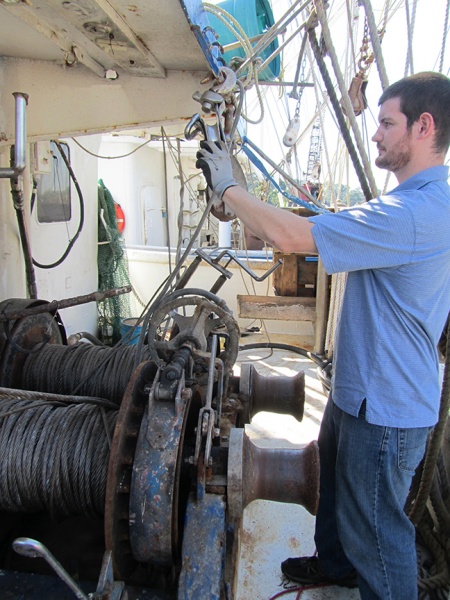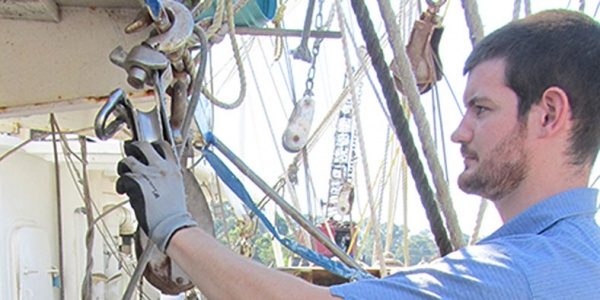David Sweet jumped in with both feet when he became a mechanical engineering contractor for the National Institute for Occupational Safety and Health’s (NIOSH) Commercial Fishing Safety Research and Design Program. A 2016 graduate of Gonzaga University, he parlayed an engineering senior design project into his first post-college job with NIOSH’s Western States Division (WSD) in Spokane through enthusiasm and a meticulous approach to addressing challenges in engineering safety interventions for the commercial fishing industry.
His team’s mission was to develop methods for further preventing winch entanglement injuries among shrimp fishermen in the Gulf of Mexico. NIOSH engineers had already identified four major factors contributing to winch entanglements among these workers and begun the work of developing retrofittable guard systems to address entanglement in the main winch drums. David’s team began working on solutions to prevent fishermen from becoming entangled in the winches rotating catheads. David says that first experience taught him, “that one problem can have several different factors to consider and it is our job as engineers to make sure we have thought through each of these factors before we can produce a worthy and acceptable solution.” This focus on acceptability by the end user is a key component of NIOSH’s research to practice ethos, and a key feature of WSD’s approach to engineering solutions for the fishing industry.
After graduation David joined NIOSH as an engineering contractor and continued to support the winch guard project. He was also asked to work with one of WSD’s epidemiologists to address non-fatal material handling issues on freezer trawl vessels in Alaska. These large (300’+) vessels catch, process, and package fish into 50 pounds boxes and stack them in hangar size freezer holds aboard the vessel. NIOSH research has shown that most non-fatal injuries on these vessels come from the process of moving the frozen boxes during unloading. Again, David was asked to assess the process and look for ways to apply engineering interventions to prevent crushing injuries to the hands of the workers. One of the biggest challenges faced by engineers working with commercial fishing vessels is the lack of consistency or standardization to vessel design. According to David, “The equipment, setup, process, and mindset of the workers are all different from boat to boat. As such, there are always new obstacles that must be accounted for in each design.”

David Sweet takes measurements off a 503 McElroy winch aboard the fishing vessel Elisabeth T, operating out of Intercoastal City, Louisiana.
When asked what influenced him to pursue a job with NIOSH as opposed to other large engineering companies in Washington state, the Spokane native said, “Working for a large company such as Boeing was an attractive thought, but I really want to directly help people with the work that I do and I believe working at NIOSH allows me to do that. We have a strong team here who are dedicated to that same ideal.” This stakeholder-focused mission has given David the opportunity to travel to the field on multiple occasions to see how the work is done and where his expertise might be applied to reduce injuries and fatalities. He has spent time on the docks in Washington, Louisiana, Texas, and North Carolina.
When asked where he sees himself in 5 years, the young engineer sees himself in the same place he is now, “would like to see myself continuing to develop safety interventions for workers in the commercial fishing industry. The need is strong and there are several opportunities waiting.”
Theodore D. Teske, MA, is a Health Communication Specialist in the NIOSH Western States Division.
Originally posted by NIOSH Science Blog. Reproduced with permission.
